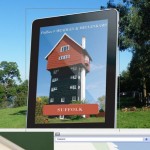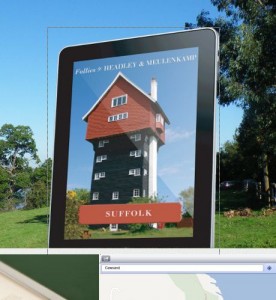Gwyn Headley must have a claim to being the leading authority on British follies – those purposless pieces of architecture that contribute so much to the greatness and gaiety of the nation. He has recently published the definitive guide Follies of England, available in a series of county-by-county ebooks from the usual outlets and from www.heritage.co.uk. We hope that Gwyn will be bringing you a series of posts over the coming weeks, but for now he explains the ebook project and his lifeling obsession with follies…
I’ve been gainfully unemployed since I was 29. That’s coming up to 40 years ago. Any income I’ve made has been by the sweat of my own brow — I’m too feeble to have made it as a miner, and too feeble-minded to make it as a thinker. Twelve schools in 16 years put paid to academic aspirations, but burdened (or blessed) with a lively curiosity I became an amateur, in the proper sense of the word, a cognoscente. A dabbler, if you wish. I dabbled in rock and roll. I dabbled in writing. I dabbled in PR. I dabbled in ornithology. I dabbled in estate agency. I dabbled in photography. I dabbled in heritage. Pretty much the only thing I didn’t dabble in was politics.
Or follies. From the age of five, when my father took me to Broadway Tower and explained that this lonely tower on a raging hill was called a folly, because the person who built it simply wanted to build it, I was entranced. A huge tower, in the middle of a field; no road or path leading to it. No garden. No one at home. No rhyme. No reason. I loved it. No dabbling here. I fell right in. Total immersion. And that passion has stayed with me for sixty years, hanging round my neck like an affectionate albatross.
I tried to expunge it by writing a book on the subject. That didn’t work, because I then wrote six more. I co-founded a charity to look after the bloody things, The Folly Fellowship, but they threw me out because I wasn’t a team player. If I’m not a team player, what the hell are follies, then?
Follies are misunderstood buildings, just as I am a misunderstood man (except by my wife, who knows me very well). You can build a church, a castle, a house or an office, but you can’t set out to build a folly. It’s an honorarium; only other people may grant your monstrous erection the title of Folly. For you, of course, it’s a perfectly sensible structure.
Now along with all my other failings, I am reasonably incompetent around the home. Wood splits when it sees me. Plaster collapses. Fuses blow. Stone remains impervious. Building something would not only be dangerous, it would be folly. So I restricted myself to finding pre-existing follies, tracking them down, discovering what made the builder tick, and writing about them. And after six books published by brave, misguided publishers such as Jonathan Cape, John Wiley & Sons and Weidenfeld & Nicolson (and next year the National Trust) I gradually became aware that more and more people seemed to be reading books on devices rather than paper.
I bought one of these devices. Damned clever it was too, but it didn’t have anything about follies, and what use is an iPad if it can’t supply you with an ebook or forty on follies, I thought.
My co-author and fellow folly fanatic Wim Meulenkamp, a distinguished Dutch art historian, and I decided to do something about this. Last month we published Follies of England, a county-by-county guide and tribute to England’s world-class eccentricity in architecture. Over 250,000 words, split over 40 ebooks to put them into handy bite-sized chunks, and more than 1,900 photographs, the majority from the brilliant stable of photographers at fotoLibra, go to create what we suspect is the biggest digital heritage ebook project ever published. Inevitably there’s more to come — Follies of Wales and Follies of Scotland will arrive early in the New Year.
We created a website — heritage.co.uk — and began to sell the ebooks off it, starting at 99p. The labourer is worthy of his hire. The ebooks are in both EPUB and MOBI formats, so they can be read on any ebook reader. Because Amazon’s Kindle reduces our glorious photographs to 16 thrilling shades of grey, we prefer to read them on an iPad, but the new Kindle Fire coming before Christmas will show them in colour, as will Kobo’s new ereader. And of course they can be read on any Smartphone such as the Android or iPhone.
Reading them on a 3G device is best, because then our clever Active Location Finder know-how is enabled. This means you can tap on a building in the ebook and be instantly transported to a map showing you how to get to the folly from where you are standing, whether motorway or wild, wet wood. “We call it ‘Know-How’,” comments Wim Meulenkamp laconically, “because Technology is the name we give to something that doesn’t quite work yet. This works.”
Is this any way to scratch out a living?




















This is a terrific idea. I’ve been looking for an excuse to buy an iPad, and now I think I’ve found a reason. I’m already a fan Hedley and Meulenkamp’s conventional books on follies, but this new venture is a wonderful way of extending the appreciation of these misunderstood buildings.
I too am a sucker for follies, and am looking forward to reading more about them! I shall download the warwickshire one for my iphone and squint at it
Ditto Glos.
Great stuff, Gwyn.
Now here at last is a compelling Dabblerish use for an iPad – carry it around the county spotting the follies and learning about them in glorious technicolour.
I don’t actually own an iPad, so if anyone fancies solving that problem, email me at editorial@thedabbler.co.uk
Before Gwyn, Barbara Jones’ great book was the must-have on follies, wasn’t it? But – like the more recent editions of Pevsner – it was never exactly something you’d carry into the field with you, no matter how much you might want to. So this is precisely the kind of use that brings ebooks into their own, especially on a gorgeous platform such as the iPad.
And it’s one of those moments when the charge of philistinism begins to stick to the “real books” dead-enders, and about damn time too. Excellent work, Mr. Headley.
up til now I’ve always consulted the Shell Guides Country Alphabet and Shell Guides Mysterious Britain for my folly related jaunts, looking forward to going technomological